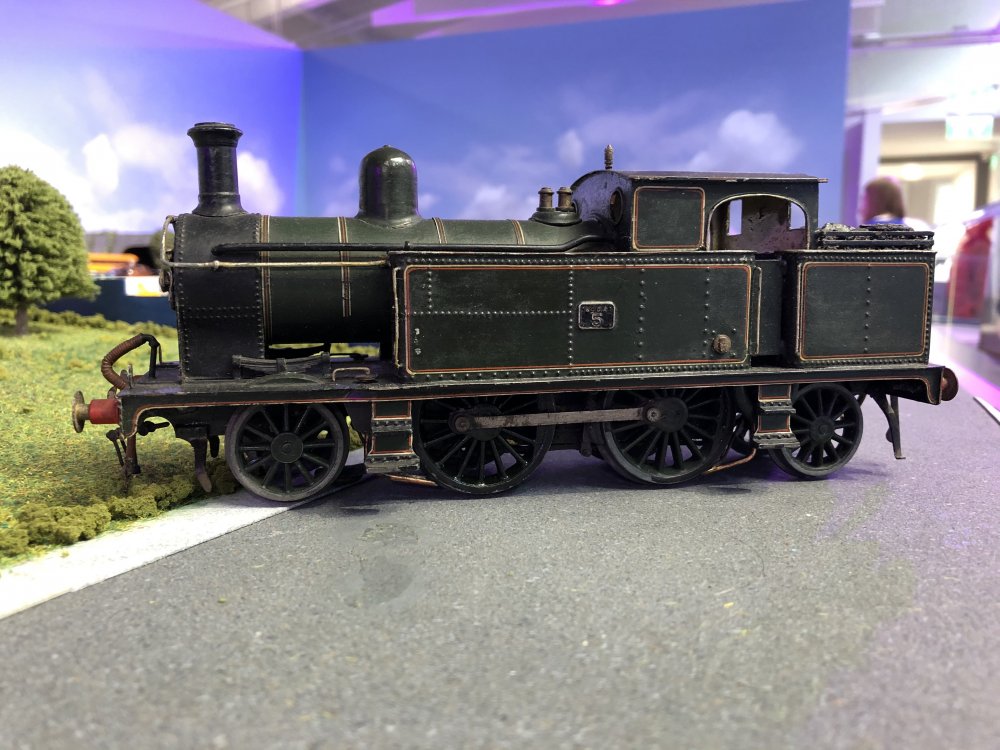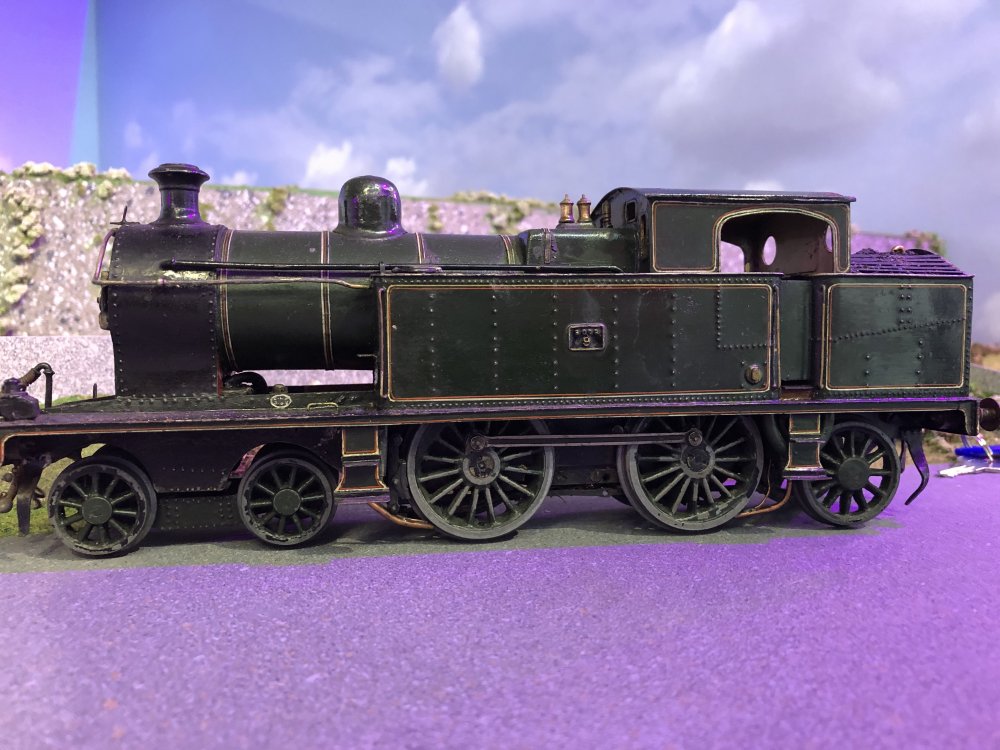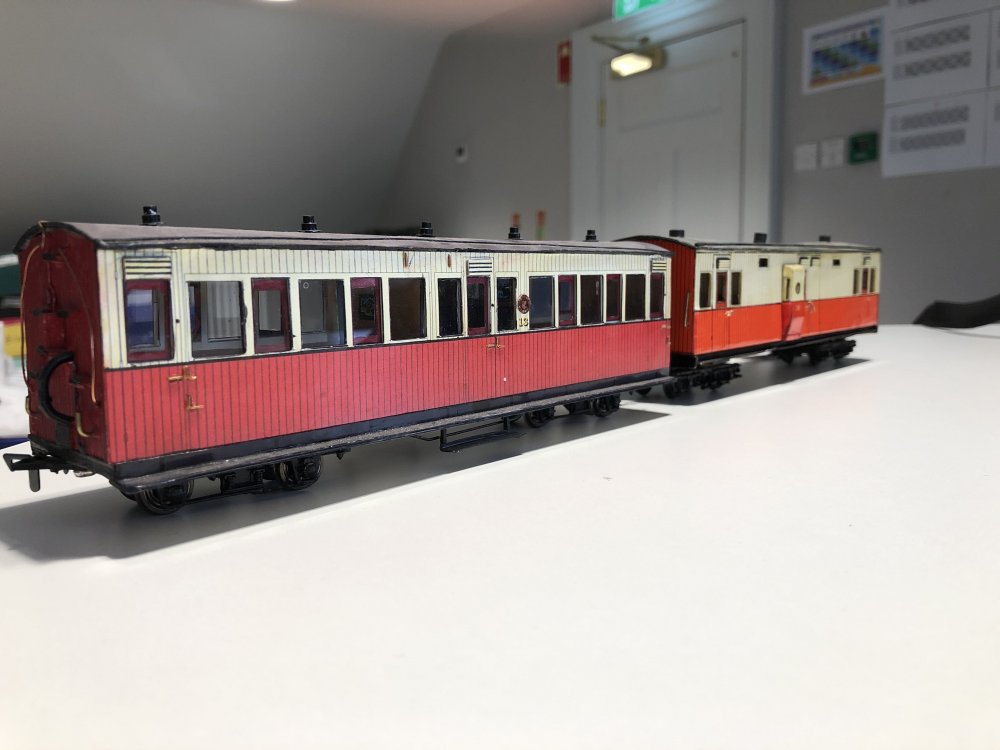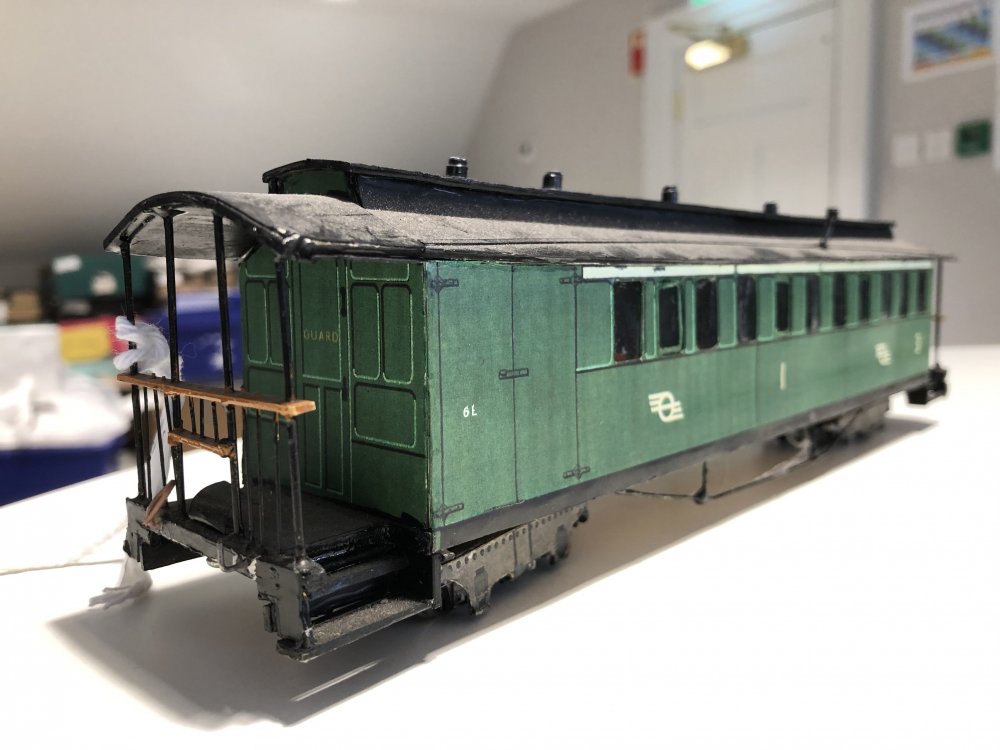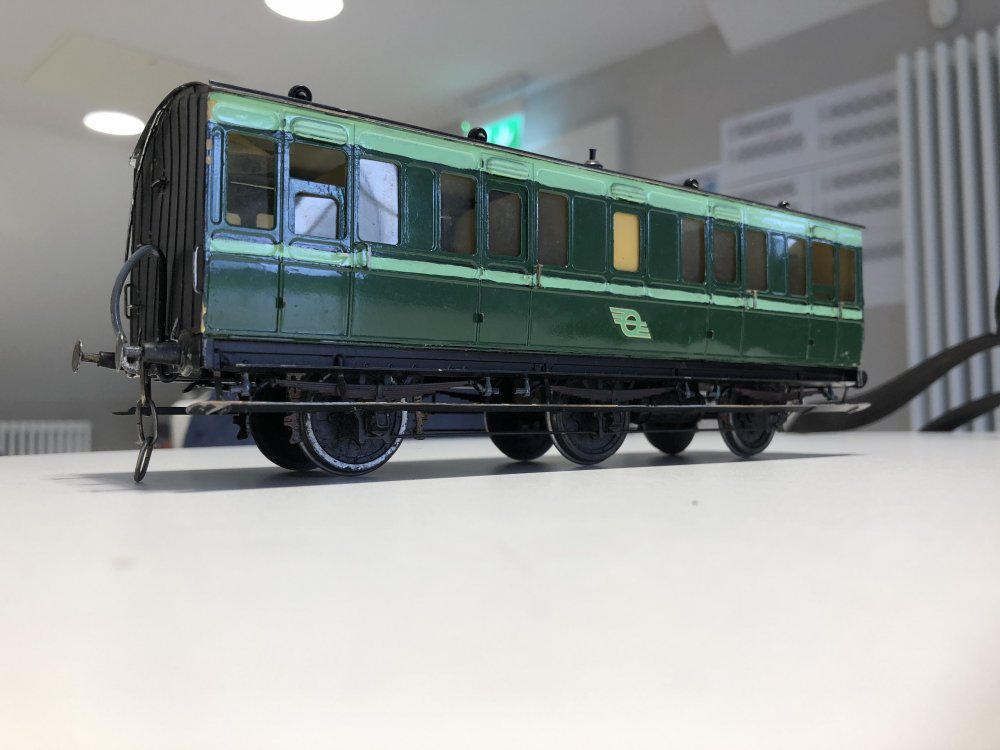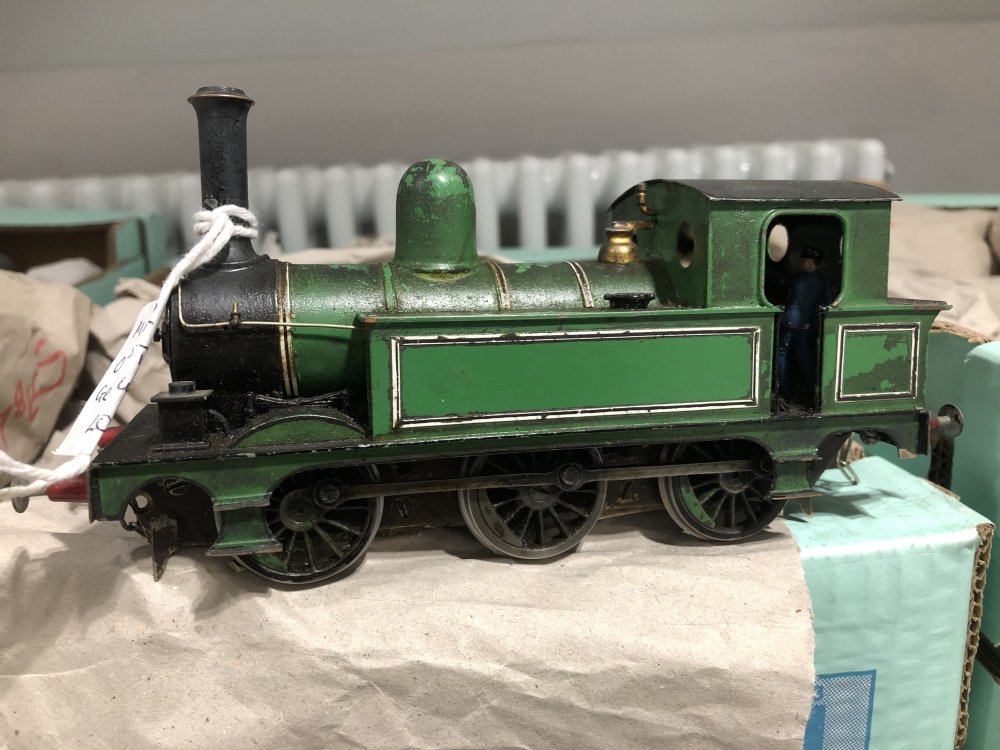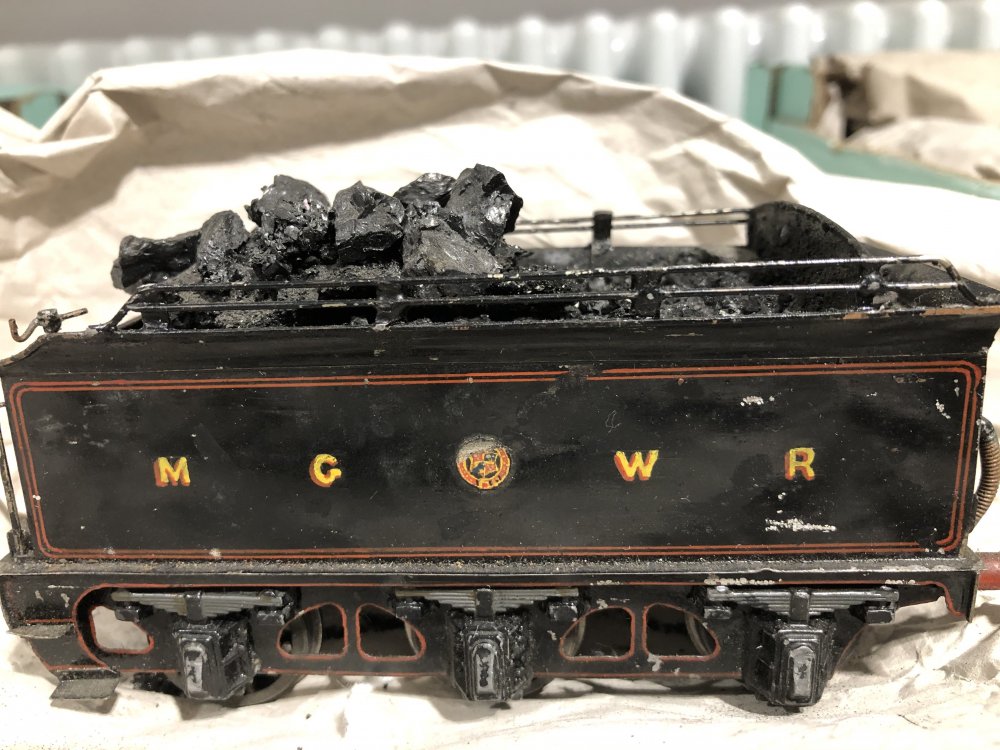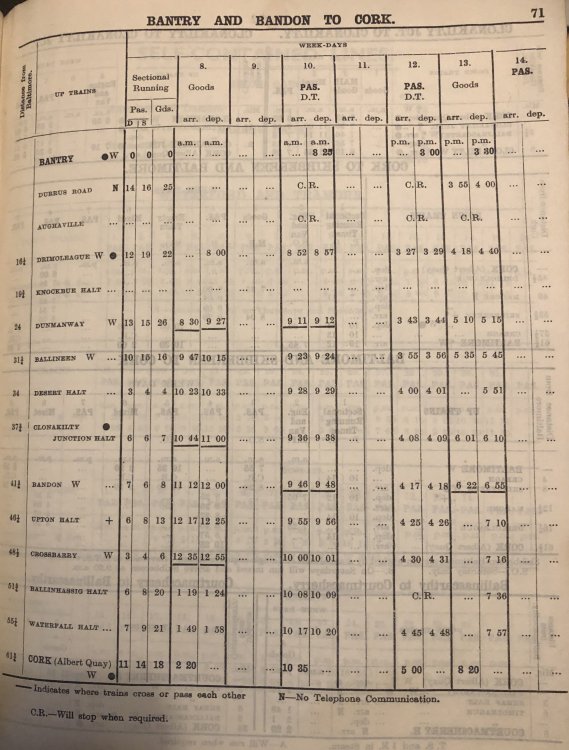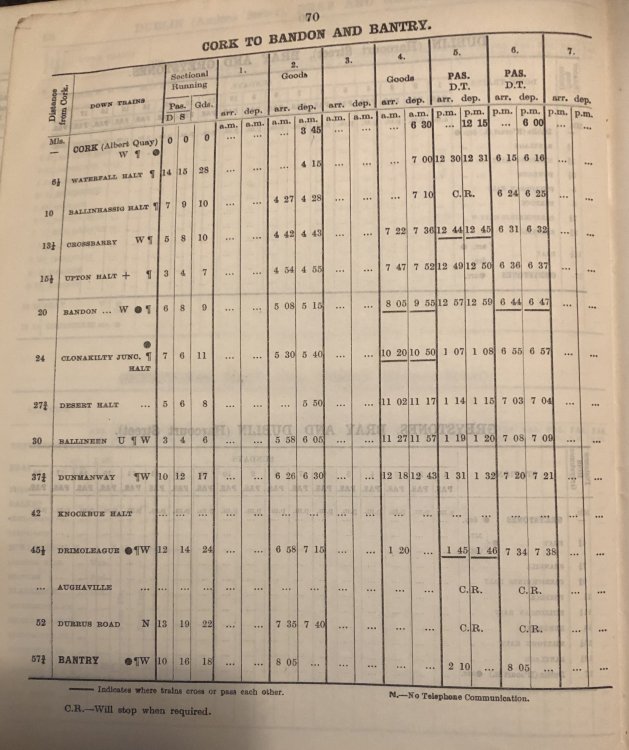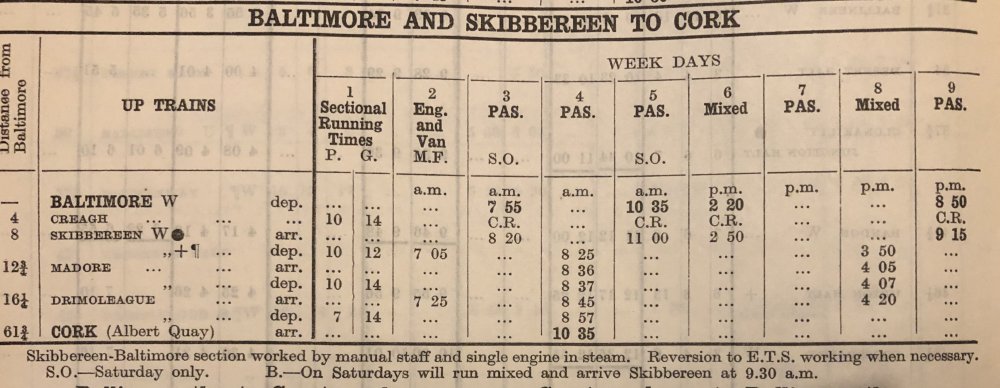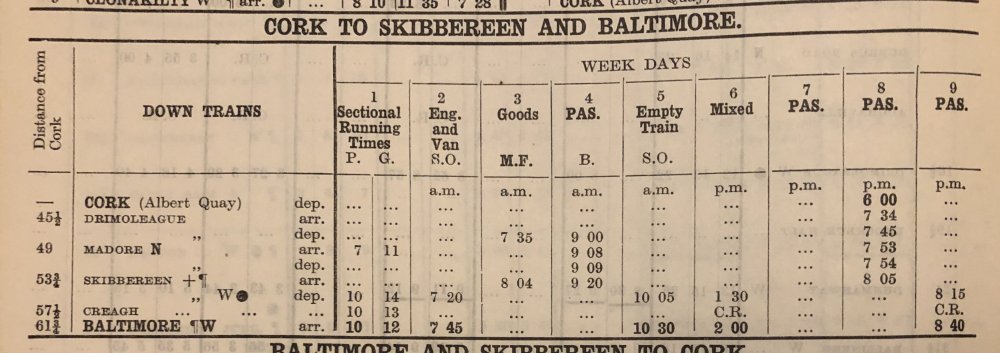-
Posts
15,859 -
Joined
-
Last visited
-
Days Won
393
Content Type
Profiles
Forums
Events
Gallery
Everything posted by jhb171achill
-
Not to my knowledge, DART8118, but I will be speaking next week to one who will know! I should also be speaking to Fry’s daughter, an absolutely lovely lady. She has followed all developments since C L Fry died in 1972, and she can tell you absolute chapter and verse of all moves; some of which had her support, and others she was not happy about back in the day. A book about Fry and his achievements is under way. I am very anxious to ensure that she thoroughly endorses every syllable in it! I will see what I can find out about DLR Council.
-
Had these out today to show someone... Two BCDR locos (livery note; this is actual BCDR green - No. 30’s Isle of Man-esque green in Cultra is WAAY too light! The MGWR tender has, I am sure, a matching loco somewhere; thus far it maintains its secrecy. The six-wheelers are the excellent SSM kits. The very nice Donegal carriages and C & L brake compo No. 6L are very nice alphagraphix kits by the look of them. These were made up by Des McGlynn. All items shown here, MGWR tank loco included, were made in the 1990s / 2001 for the Malahide Castle layout, rather than by Fry - with the exception of the two BCDR locos. Fry made them.
-
My error entirely! I knew about the nationalisation dates but the canal detail slipped my mind!
-
It’s become “colloquial”, though. With anyone involved in developing it long since passed away, hopefully there’s nothing derogatory about it. It’s been referred to as such for half a century now anyway.... “Wheel” is, of course, a very appropriate name, though with relatives in Inchicore myself I never heard of it!
-
1. The “Flying Snail” (as in my avatar thingy) was used by the Dublin United Tramways Co on their trams and buses from 1941. They had the company name in Irish across the central bar. In 1945 the DUTC was amalgamated with the Grand Canal Co., and the Great Southern Railways to form CIE, and the entire organisation used it, without any wording across the middle. I am unaware of any use of “on the ground” in the canal world, other than newspaper notices, but that’s another story. Evidently, the snail was based on the London Underground logo. 2. The “snail” was replaced by the “broken wheel” in 1962, but it would be several years before the new logo was a common sight; goods vans were still carrying occasional examples over ten years later - the last “snail” I saw on a goods van was, I think, 1976 or 1977. 3. On the breakup of CIE into operation g subsidiaries in 1987, the “set of points” appeared. At this stage they stopped applying any logos to almost all freight wagons. I saw a few ballasts with it, but 42ft flats and fertilisers were niw pksin brown without logos. That said, tired and weathered “broken wheels” could be seen on a few ferts right until they stopped running. 4. The “3-pin plug”, referred to above, about mid-1990s. 5. The “N-shaped flag”, 2013. I agree that it’s not by a very long way the most impressive logo I’ve ever seen!!!! Whats next..........?
-
CASINO MUSEUM & FRY COLLECTION UPDATE Now that the Casino Museum is open, up and running, some final tweaks still need to be made. A little tweaking of the interactive displays will be made over the coming weeks and months, and attention is now being turned to the future os redundant material from the erstwhile "Castle" layout. Remember, the layout in the castle was NOT Fry's, nor were the locos and rolling stock which ran on it. A full evaluation of this very considerable amount of material is being conducted over the coming weeks, in particular what if anything can be done with the huge amount of stored pieces of the castle layout. Anyone got a heated attic about 55 x 30 feet, upon which a very considerable weight (many tons) can be placed?!! Within the Casino, visitor numbers are healthily increasing and it is my hope that some of Fry's British or mainland European models may be able to be displayed. Currently, there's no room other than one small display case.
-
K801, in a perfect world they could - and what a highly scenic line that would have been. I believe that the original promoters of the Youghal line had ideas about going further....... pity it didn't happen.
-
Indeed it is, though as you can see, covered in weeds and sundry gunk....
-
Am I right in thinking we're looking at mass closures, 1957-63-style, or BnM railways in the next couple of years?
-
If it’s of any use, I made some card models in my teens and I used matchsticks to strengthen and strsighten the corners inside.
- 19 replies
-
- 1
-

-
- rolling stock
- card
-
(and 1 more)
Tagged with:
-
Some of our modellers do the 21mm gauge track - it looks so much better!
-
CIE-built 1950s Wooden Coaching Stock (Pre - Laminate Stock)
jhb171achill replied to DiveController's topic in Irish Models
Very true! And many another dangerous practices too.....- 17 replies
-
- cie
- wooden coach
- (and 6 more)
-
CIE-built 1950s Wooden Coaching Stock (Pre - Laminate Stock)
jhb171achill replied to DiveController's topic in Irish Models
Indeed, very interesting info. In my days restoring RPSI carriages, I never recall any with asbestos either. Locos had it of course, and in the days before health and safety was invented, it was just pulled off by hand and put in the bin!- 17 replies
-
- cie
- wooden coach
- (and 6 more)
-
Goes to show how we've moved on, again, and I've said it many times before, thanks to the great crop of model-manufacturers both kit and RTR, that we have now. It should always be remembered by all of us that these guys are putting good-sized five figure sums into the production of an item and for what commercially is a very small market indeed. Praise be to them all! Sure back when I was a mere stripling, back when pussy was a kitten, Irish modelling meant crudely painting a BR Mk 1 in orange and black, or sticking paper sides over it, carefully coloured in with marker pen! Actual RTR stuff? Pipe Dream!
-
In reality, as my above post tries to illustrate, we will all have our favourites over time..... When the NIR 80 class came out and were in full service, many enthusiasts and modellers ignored them, yet historically as we now know they played a vitally important role in the revival of railways in the north and were the staple for over thirty years of almost all services. Thus, quite rightly, the preserved set at Downpatrick is a very valuable piece of our railway heritage indeed. I often say here that post-1970, I am personally out of my own interest zone, but that's nothing but my own personal opinion. ICRs have played a part in keeping rural lines going, not unlike the role played by AEC cars in the 1950-70 period, all over Ireland. Indeed, had the funds been forthcoming for more, it's likely that much of the GNR would have lasted at least a little longer. The ICRs will eventually have their own place in history. Personally, I'll bash them from Broadstone the whole way to Killala, but there's no denying they do what they were bought to do. And in the overall story of iris railways, that's all good. Tomorrow, I will travel from Cork to Dublin in one..... Within our world of models, I do actually believe that an IRM / Murphy standard RTR ICR set would be a winner. If made by either of those, it would actually be a thing of beauty!
-
As far as RTR is concerned: 2 or 3 varieties of laminates / 1950s CIE coaches AEC cars in GNR (UTA, NIR) styles, and CIE styles. Palvan Outside-panelled GSR / CIE goods van K15 coach (GNR brown, GNR navy / cream, CIE green, black'n'tan, UTA green, NIR maroon / grey) "C" class NCC "Jeep". 80 class railcar set, at least in original and "wasp lining" liveries MPD railcar
-
Did you do the artwork for it? Looks great! Huge potential there.
- 19 replies
-
- 1
-

-
- rolling stock
- card
-
(and 1 more)
Tagged with:
-
CIE-built 1950s Wooden Coaching Stock (Pre - Laminate Stock)
jhb171achill replied to DiveController's topic in Irish Models
The similarities would probably be coincidental, as Edgar Bredin and his team tended to start from scratch with everything. However - that's not to say that similarities didn't exist. In jhbSnrSnr's time, frequent forays were made by senior coach and loco people from Inchicore to Derby, and vice versa. Some of the technical innovations on the 800 class (I have to confess to having entirely forgotten which) were copied in designing the BR standard classes in the early 1950s. The least technical, but most obvious "cross-pollination" of ideas, as far as Derby was concerned anyway, was the introduction in 1933 by the GSR of exactly the same carriage livery that the LMS had, lining and all! The only differences were the omission of the LMS crest and lettering "LMS", and the inclusion of the GSR crest, and slightly larger door numbers. Like the NCC, much secondary stock didn't get any lining at all. Same maroon - dead easy for GSR modellers. Absolutely fascinating and invaluable information, exciecoachbuilder....- 17 replies
-
- 1
-

-
- cie
- wooden coach
- (and 6 more)
-
Ach now.... My own distaste for all things "modduren" begins with 071s and Hunslet Enterprises. But each to their own; jhb171Senior would have looked blankly at a B101, B113, D class or Donegal Railcar and walked away..................they didn't breathe shteam! There will come a day, I do tell ye, when the baby gricelings of the day, once they pass pension age (101, as it will then be, under FFG) look back in nostalgia, and pore over old pictures of the ICRs and CAFs and 201s that they remembered their dads taking them on the last run of, before the global warming an'all that stuff. Senior also used to recall his time in Blackburn, Lancashire, as the Blackburn District PW Engineer, where he worked about 1939-44. The LMS men around him referred to the "Black 5's" as the "new engines", thus Senior saw them as such too.... It's all relative. Having said all that, no, I've no interest in ICRs either, but they're better than a greenway......
-
There can be few lines other than the main line which saw B101, B121, B141, A & C classes in that period. It seems that the AEC cars weren't regulars there either, unless I'm mistaken? All in all, then, an excellent candidate for a layout.....
-
The following is from 1955. Now this Is very interesting to compare with the 1930 (all-steam) and 1960 (all-diesel*) timetables. Here, the main line passenger trains are all diesel (AEC railcars), whereas ALL goods and branch mixed / passenger remain steam. (Bar the odd steam extra or substitution; all REGULAR services were diesel then). Some interesting observations. 1. Was there still a loco based at Courtmacsherry, of all places? I doubt it, yet the timetable has a loco and goods going out of there in the morning and coming back midday. I would have guessed that it would have been better to have the Clonakilty loco just take any goods in there from the junction, and go back later? If there was not a loco based there, then a loco and van would have had to go in there and out again in advance of, and after, the daily goods train. Where did it come from - Clon Junction? And if so, why is it not listed as a light working? 2. On the Clonakilty line, one engine, a goods van and a six-wheel passenger brake appear to have been stationed there. The loco and van do the first return trip, with the loco and brake coach doing the other two runs. 3. The railcar set does two return trips on the Cork - Bantry route - fine. But the goods - one return train from Albert Quay to Bantry and back, and one, on the face of it, to Drimoleague. However, what happens next beggars belief, as I had noticed before: 4. .....and that is this. Look at the Drimoleague to Baltimore service, crewing and locomotive requirements. It beggars belief that such complex and (to the travelling public) inefficient and downright pointless movements could replace rationality! The goods train could just continue and come back, a la Bantry, and a local passenger set could just do two workings from Baltimore to Drimoleague to meet the main line train there. But look.... firstly, apart from the disjointed workings during the day, which seem to treat Skibbereen to Baltimore as an entirely separate line, the 19:34 from Drimoleague only goes as far as Skibbereen. However, there is a 20:50 departure from Baltimore up to Skib and back, connecting with nothing. Does this mean that there is a loco stabled there (as late as 1955, anyway) just to do this? More likely, the 19:34 ex-Drimoleague just goes on to Baltimore light, but (a) why doesn't it just continue as a passenger train, and (b) why isn't any such working in the WTT? 5. It appears that the goods engine from Cork to Drimloleague just goes back to Cork. Why not continue to Baltimore and then go back? A crew change, if required, wouldn't exactly be rocket science to organise....... So, we have two locos on the Cork to Drim goods (they cross at Clon Jct), one on the Cork - Bantry return goods. A branch loco on the Clon and Court lines, apparently, and one or possibly two on Drim - Baltimore. Add a shunter at Albert Quay. Thus, without spare locos, the daily traffic requirement is some 7 or 8 locomotives, whereas after dieselisation this fell eventually to five "C" class. Five drivers instead of eight drivers, eight firemen and about 6 or 7 steam raisers. AND - they’re all the right way up! Howzat! Can we dare to imagine what a 121, a B101, an A or a modern ICR would have been like on the West Cork? In the 1960s and 70s, it is likely that the line would have been monopolised by 141s with three-coach laminate trains, possibly providing a home for tin vans into the 1980s. Goods - apart from beet, you might have had fert and Guinness, and possibly oil traffic from Bantry. Oil liners? Pairs or 071s into Bantry? We can but dream. I can't help feeling that ordinary goods traffic would have died in 1975/6, though maybe a container terminal at Bandon would have figured into the 1980s. Mind you, if open now, I daresay IE would treat it like Waterford to Limerick - doing their best to run it down by putting a 2600 on it, and substituting buses whenever they could!
-
CORRECTION: I'm just re-reading my original comment on a pair of 121s.... I said it was 1972 - that's a typo - it was 1973!
-
The train featured at 2:30 seems unusually long for this service - I wonder was there a story behind it? And at 6:12 onwards, we seem to have a B101 hauling a presumably deceased "C"! A superb video.
-
It was Indeed, that’s how I remember it. It was a midday or early afternoon stopping train to Cork, leaving what is now platform 5. The leading one anyway, but I think both, was newly painted in “supertrain”, the first time I had seen this livery in a 121. We we’re leaving my cousin onto the train to go to Mountrath..... happy days....
.png.c363cdf5c3fb7955cd92a55eb6dbbae0.png)

